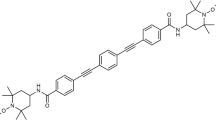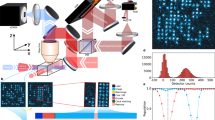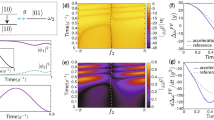Abstract
A significant development in computing has been the discovery1 that the computational power of quantum computers exceeds that of Turing machines. Central to the experimental realization of quantum information processing is the construction of fault-tolerant quantum logic gates. Their operation requires conditional quantum dynamics, in which one sub-system undergoes a coherent evolution that depends on the quantum state of another sub-system2; in particular, the evolving sub-system may acquire a conditional phase shift. Although conventionally dynamic in origin, phase shifts can also be geometric3,4. Conditional geometric (or ‘Berry’) phases depend only on the geometry of the path executed, and are therefore resilient to certain types of errors; this suggests the possibility of an intrinsically fault-tolerant way of performing quantum gate operations. Nuclear magnetic resonance techniques have already been used to demonstrate both simple quantum information processing5,6,7,8,9 and geometric phase shifts10,11,12. Here we combine these ideas by performing a nuclear magnetic resonance experiment in which a conditional Berry phase is implemented, demonstrating a controlled phase shift gate.
This is a preview of subscription content, access via your institution
Access options
Subscribe to this journal
Receive 51 print issues and online access
$199.00 per year
only $3.90 per issue
Buy this article
- Purchase on Springer Link
- Instant access to full article PDF
Prices may be subject to local taxes which are calculated during checkout


Similar content being viewed by others
References
Shor, P. W. Polynomial-time algorithms for prime factorization and discrete logarithms on a quantum computer. SIAM Rev. 41, 303–332 (1999).
Barenco, A., Deutsch, D., Ekert, A. & Jozsa, R. Conditional quantum dynamics and logic gates. Phys. Rev. Lett. 74, 4083–4086 (1995).
Berry, M. V. Quantal phase factors accompanying adiabatic changes. Proc. R. Soc. Lond. A 392, 45–57 (1984).
Shapere, A. & Wilczek, F. Geometric Phases in Physics (World Scientific, Singapore, 1989).
Cory, D. G., Fahmy, A. F. & Havel, T. F. Ensemble quantum computing by NMR spectroscopy. Proc. Natl Acad. Sci. USA 94, 1634–1639 (1997).
Gershenfeld, N. A. & Chuang, I. L. Bulk spin-resonance quantum computation. Science 275, 350–356 (1997).
Jones, J. A. & Mosca, M. Implementation of a quantum algorithm on a nuclear magnetic resonance quantum computer. J. Chem. Phys. 109, 1648–1653 (1998).
Chuang, I. L., Gershenfeld, N. & Kubinec, M. Experimental implementation of fast quantum searching. Phys. Rev. Lett. 80, 3408–3411 (1998).
Cory, D. G., Price, M. D. & Havel, T. F. Nuclear magnetic resonance spectroscopy: An experimentally accessible paradigm for quantum computing. Physica D 120, 82–101 (1998).
Suter, D., Chingas, G., Harris, R. & Pines, A. Berry's phase in magnetic resonance. Mol. Phys. 61, 1327–1340 (1987).
Goldman, M., Fleury, V. & Guéron, M. NMR frequency shift under sample spinning. J. Magn. Reson. A 118, 11–20 (1996).
Jones, J. A. & Pines, A. Geometric dephasing in zero-field magnetic resonance. J. Chem. Phys. 106, 3007–3016 (1997).
Deutsch, D., Barenco, A. & Ekert, A. Universality in quantum computation. Proc. R. Soc. Lond. A 449, 669–677 (1995).
Jones, J. A., Hansen, R. H. & Mosca, M. Quantum logic gates and nuclear magnetic resonance pulse sequences. J. Magn. Reson. 135, 353–360 (1998).
Ernst, R. R., Bodenhausen, G. & Wokaun, A. Principles of Nuclear Magnetic Resonance in One and Two Dimensions (Clarendon, Oxford, 1987).
Sørensen, O. W., Eich, G. W., Levitt, M. H., Bodenhausen, G. & Ernst, R. R. Product operator-formalism for the description of NMR pulse experiments. Prog. Nucl. Magn. Reson. Spectrosc. 16, 163–192 (1983).
Jones, J. A. & Knill, E. Efficient refocussing of one spin and two spin interactions for NMR quantum computation. J. Magn. Reson. 141, 322–325 (1999).
Pellizzari, T., Gardiner, S. A., Cirac, J. I. & Zoller, P. Decoherence, continuous observation, and quantum computing: a cavity QED model. Phys. Rev. Lett. 75, 3788–3791 (1995).
Averin, D. V. Adiabatic quantum computation with Cooper pairs. Solid State Commun. 105, 659–664 (1998).
Kitaev, A. Y. Fault tolerant quantum computation with anyons. Preprint http://arxiv.org/quant-ph/9707021.
Preskill, J. Fault tolerant quantum computation. Preprint http://arxiv.org/quant-ph/9712048.
Acknowledgements
We thank N. Soffe for helpful discussions. J.A.J. and A.E. thank the Royal Society of London and Starlab (Riverland NV) for financial support.
Author information
Authors and Affiliations
Corresponding author
Rights and permissions
About this article
Cite this article
Jones, J., Vedral, V., Ekert, A. et al. Geometric quantum computation using nuclear magnetic resonance. Nature 403, 869–871 (2000). https://doi.org/10.1038/35002528
Received:
Accepted:
Issue Date:
DOI: https://doi.org/10.1038/35002528
This article is cited by
-
Quantum phase gates with geometric phases of spin-orbit modes
Quantum Information Processing (2024)
-
Geometric Phase of a Two-level System Driven by a Classical Field
International Journal of Theoretical Physics (2024)
-
Dynamically crossing diabolic points while encircling exceptional curves: A programmable symmetric-asymmetric multimode switch
Nature Communications (2023)
-
Experimental observation of Berry phases in optical Möbius-strip microcavities
Nature Photonics (2023)
-
Quantum Optimal Control: Practical Aspects and Diverse Methods
Journal of the Indian Institute of Science (2023)
Comments
By submitting a comment you agree to abide by our Terms and Community Guidelines. If you find something abusive or that does not comply with our terms or guidelines please flag it as inappropriate.



